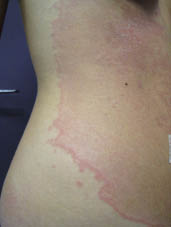Rosalind Hughes1, Jean-Philippe Lacour1, Bernadette Baldin2, Marc Reverte1, Jean-Paul Ortonne1 and Theirry Passeron1
1Department of Dermatology and 2Centre Régional de Pharmacovigilance, University Hospital, 151, Route de Saint-Antoine-de-Ginestière, Nice, France. E-mail: passeron@unice.fr
Accepted May 18, 2010.
The first case of a novel influenza infection was reported in Mexico in April 2009. The swH1N1 influenza A strain, which is an amalgamation of swine, bird and human influenza (1), has subsequently spread across the world, creating the first influenza pandemic since 1968.
H1N1 vaccines are available as a live, attenuated monovalent vaccine (LAMV) for intranasal administration and as monovalent, inactivated, split-virus or subunit vaccines (MIV) for injection. The MIV is available with and without adjuvants. Outcomes of studies completed to date suggest that pandemic vaccines are as safe as seasonal influenza vaccines. Side-effects reported so far are similar to those observed with seasonal influenza vaccines. Urticarial vasculitis following H1N1 vaccination has not been reported previously.
Case Report
We report here a case of a 21-year-old woman who received a MIV without adjuvant (Panenza®, Sanofi Pasteur, Val de Reuil, France). Six days after vaccination, the patient experienced widespread pruritus, followed 3 days later by a rash. The rash began on the lower abdomen and quickly spread to involve the entire trunk and legs. It consisted of confluent, well-demarcated fixed urticarial plaques with an erythematous boarder (Fig. 1). Annular lesions on the legs exhibited central purpura and peripheral pallor. The patient did not experience arthralgia. She had no medical history of any similar condition and took no medication. She was apyrexial and normotensive. All investigations were normal, including a full blood count, liver and renal function tests, C-reactive protein, anti-nuclear antibody, extractive nuclear antigens, cryoglobulins, C3, C4, Mycoplasma titres and Anti-Streptolysine O titre (ASOT). A biopsy from an affected area of skin confirmed a diagnosis of urticarial vasculitis. Direct immunofluorescence was negative. The patient was prescribed anti-histamines for 10 days. The rash resolved gradually over two weeks with residual post-inflammatory hyperpigmentation.
Fig. 1. Confluent, well-demarcated fixed urticarial plaques with an erythematous, indurated border and some scaling of earlier lesions.
Discussion
Studies completed to date suggest that pandemic vaccines are as safe as seasonal influenza vaccines and have a similar side-effect and adverse event profile. The most frequently reported severe adverse event to date is anaphylaxis. The Centre for Disease Control in the USA has shown that, since licensing of the first influenza vaccine, until December 2009, the percentage of serious adverse events (SAE) among all adverse events reported after receipt of seasonal influenza vaccines was slightly higher (6.1%), compared with the percentage of SAE after receipt of H1N1 vaccines (5.4%) (2).
Several cases of leukocytoclastic vasculitis following seasonal influenza vaccination have been reported (3–5). This typically occurs between one and two weeks after vaccination. The most common presentation reported is a purpuric eruption on the lower limbs, and the majority of cases have shown evidence of systemic involvement. Tavadia et al. (3) reported 4 such cases, all of which had proteinuria. Glomerulonephritis and acute renal failure (5) have also been reported. Urticarial vasculitis following H1N1 vaccination has not been reported previously. Searching in the French Pharmacovigilance system database, we found another case of urticarial vasculitis reported in a 72-year-old man 15 days after vaccination with adjuvanted MIV (Pandemrix®, Glaxo SmithKline Biologicals, Paris, France).
Overall, H1N1 vaccines appear to be very safe, with a favourable adverse event profile. We report this case to highlight awareness of rare, yet potentially debilitating adverse events following H1N1 vaccination.
References




